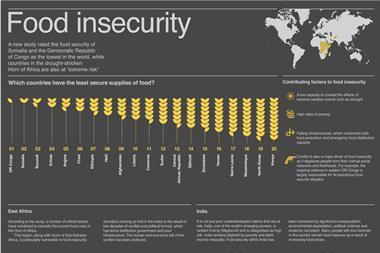Lack of stable supplies may contribute to future oil price hikes and regional unrest
Extreme water security risks across the Middle East and North Africa (MENA) may lead to further increases in global oil prices and heightened political tensions in the future, according to a new study, which rates the region as having the least secure water supplies in the world.
The Water Security Risk Index and map, developed by risk analysis and mapping firm Maplecroft, rates 18 countries at ‘extreme risk’ with 15 located in the troubled MENA region.
These include: Mauritania (1), Kuwait (2), Jordan (3), Egypt (4), Israel (5), Niger (6), Iraq (7), Oman (8), United Arab Emirates (9), Syria (10), Saudi Arabia (11), Libya (14), Djibouti (16), Tunisia (17) and Algeria (18).
The index and map has been developed to enable business and investors to identify the countries where water supply will be limited or interrupted in the future.
Maplecroft calculates water security by measuring countries’ water stress; population rates; reliance on external water supplies; sustainability of water use; intensity of water use in the economy; government effectiveness; and virtual water use, which is a unique assessment of the water intensity of imported goods, such as food and oil.
Of the 12 Organisation of the Petroleum Exporting Countries (OPEC) members, six - Algeria, Iraq, Kuwait, Libya, Saudi Arabia and the UAE, are in the highest risk category, whilst a further two - Iran and Qatar - are rated ‘high risk.’ Collectively, these countries produced approximately 30% of global oil production in 2009, whilst the countries at extreme and high risk collectively produced 45% of global oil in 2009.
A lack of access to water can have a great number of direct and indirect effects and the repercussions can reverberate globally. Of particular importance to the global and local economy is the use of large quantities of water in the production of oil. “Lift water,” which some companies source from aquifers, is used to force oil out of the well that would not rise under its own pressure from the geology. This process is undertaken to prolong the economic lifespan of the well, and allow a greater volume of oil to be extracted. If sufficient water is not available productivity will decrease and operations will be interrupted, which could significantly affect global oil supply and prices.
Many oil producing countries in the MENA region bare legacies of conflict. While theories of ‘water wars’ are now considered less helpful, overall water shortages will bring issues such as the use of water resources that cross international boundaries into stark focus.
Reliance on transboundary water supplies in such a troubled region presents a significant risk for these countries. A long-running example of this is the use of the waters of the River Jordan. This has been central to many episodes in conflict between Israel and Jordan. Jordan’s attempted diversion of the river in 1964 is widely considered to have led to the “Six-Day War.” Article Six of the Israel-Jordan peace treaty of 1994 was devoted to the detail of water resources’ distribution. The river Jordan provides 25-30% of Israel’s water, and 75% of Jordan’s.
As water becomes scarcer in the MENA region, each country will be encouraged to safeguard its supplies by taking measures the other may see as provocative, potentially exacerbating or sparking conflict situations.
“Water security has the potential to compound the already fragile state of societal affairs in some countries,” says Professor Alyson Warhurst, CEO of Maplecroft. “For example, in Egypt water security may intensify the on-going civil tensions. In turn it is not unrelated to food security, which leads to cost of living protests and in turn violent oppression in less democratic societies.”
Technological innovations, including the desalination of salt water, may however alleviate some of these risks. The annual volume of desalinated water in Saudi Arabia is planned to double from 1.05bn m3 to 2.07m3 between 2010 and 2015 under a 5 year infrastructure spending plan. As part of these plans the world’s largest solar power desalination plant is planned to provide 10million m3 per year. Desalination accounts for about 50% of the country’s drinking water, with 40% coming from ground water, 9% from surface water and 1% from waste water.
“For business, there are three considerations,” continued Professor Warhurst. “First, studying water security is a helpful indicator of risk of societal instability. Second, water security is worsening in countries of high growth like India and China and business sectors that are intensive in water use will need to consider their impacts. Thirdly, there are good examples of business initiatives to enhance water security for communities in water stressed regions and the lessons of good practice need to be more widely disseminated.”



















